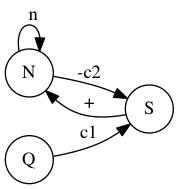There are lots of versions of the Malthusian Model. Understanding the model, which is very simple (see the directed graph, DG, above) is complicated by all the verbal expositions and criticisms of the model (Marx called it a "stain on the human race"). The model basically says that if the means of subsistence (production, Q, in the DG) does not expand as rapidly as population (N, in the graph above) then the Standard of Living (S) will decrease eventually creating a Malthusian Crisis.
From the standpoint of World-Systems Theory and Cybernetics, the Standard of Living (S) is the Malthusian Controller that keeps population growth in check. Although populations in Western Core Countries have had little or no experience with Malthusian Crises, the Malthusian model is still applicable to historical situations and may, in the future, become applicable to Western societies if Climate Change reduces Q.
You can run R-code to experiment with the Malthusian Systems Model (with feedback) here and produce the time series plot above with shock decomposition. The model is taken from Germany after Unification in 1871 when there was a brief Malthusian crisis.
Notice that after 1890, a Malthusian Equilibrium is reached when population and production are in balance.

